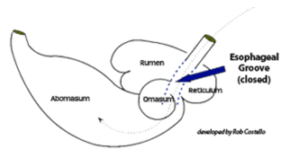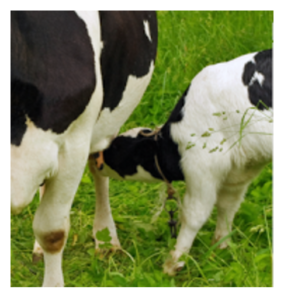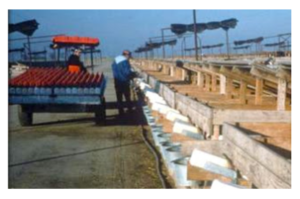~ updated August 10, 2017.
Bottle feeding vs. pail feeding of calves is always an interesting and sometimes passionate subject. There are advantages to either feeding system, and I have personally been in both camps. This article is based on research evidence. It looks at anatomical, physiological, nutritional and behavioral aspects of feeding with bottles/nipples and open pails.
Effects on the Esophageal Groove
When a calf swallows, solid food such as starter grain moves down the esophagus and passes through an opening called the esophageal groove just before it enters the rumen. Prior to weaning, milk and milk replacer take a different route. Factors such as suckling, anticipation and a variety of sensual and neural stimuli cause muscles around the esophageal groove to contract, closing the esophageal groove. This allows milk and milk replacer to bypass the rumen and flow directly into the abomasum for digestion.

The objective is to keep milk out of the rumen. When calves drink through a nipple, little if any milk ends up in the rumen — typically less than 3 milliliters. Although effective esophageal groove closure also occurs with open pail feeding, there is much more variability. Milk enters the rumen more frequently and varies from a few milliliters to well over 50% of the milk consumed. Large volumes of milk repeatedly entering the rumen can lead to serious metabolic problems. Low rumen pH, growth of yeast rather than normal rumen microbes, small distorted rumen papillae, poor production of volatile fatty acids (VFAs) and low cellulose digestion can occur. Feeding milk through a nipple provides consistent, efficient groove closure, minimizing the chance that milk will enter the rumen.
Water temperature may also affect closure of the esophageal groove. For calves accustomed to drinking milk from an open pail, drinking warm water from an open pail can cause efficient closure of the esophageal groove. This effect can continue after weaning — up to at least 16 weeks of age.
Water drinking and the esophageal groove
If things go to plan, water and solid feed enter the rumen. Water provides the medium for starter feed digestion in the rumen and encourages feed intake. When water is consumed immediately after milk feeding, the esophageal groove may still be closed. This causes water to directly enter the abomasum rather than the rumen. If this happens on a regular basis, starter intake and rumen development may be delayed.
 Body position and the esophageal groove
Body position and the esophageal groove
The more natural suckling position of a calf’s body during bottle feeding is often cited as a benefit for the calf, promoting efficient esophageal groove closure. However, the esophageal groove is not part of the esophagus. It is a functional part of the reticulo-rumen. Moving the calf’s head and neck up and down does not affect the position or reaction of the esophageal groove — unless the position is extreme. Although nursing from a bottle is a more natural position, it does not affect esophageal groove function.
Effects on digestion
When suckling a cow, a two-week old calf ingests two quarts of milk in about 3.5 minutes. At eight weeks of age it takes about 2.4 minutes. Observations obtained at a calf research facility show that suckling a nipple bottle is about 35% faster than suckling the cow, and drinking milk from an open pail is about 85% faster than the cow.
The rate at which a calf consumes liquid feed affects the rate with which the liquid moves through its digestive tract. The slower consumption rate associated with nipple feeding enhances several physiological processes associated with digestion. Saliva production is around three times greater with nipple feeding, resulting in more salivary lipase mixing with milk as it is swallowed. This begins the process of fat digestion in the calf’s abomasum.
Enzyme Secretion
Nipple-feeding also results in secretion of more abomasal enzymes. Greater enzymatic activity in gastric solutions, resulting in more effective stimulation of protein digestion in abomasal fluids.
With the secretion of more enzymes and digestive acid, more fats and proteins are digested in the abomasum when feeding with nipples. More digested nutrients flowing from the abomasum into the small intestine means there are more nutrients ready to be absorbed.
With open pail feeding, more digestion is delayed until the small intestine. With more undigested nutrients reaching the small intestine, secretion of pancreatic enzymes increases. Pancreatic enzymes enter the upper portion of the small intestine to digest the additional nutrients. The pancreas responds by increasing lipase and enzyme production. Even so, there are some physiological functions that are of concern. Fat absorption, for example, is limited to the first 30% of the small intestine. Open pail feeding narrows the time window for effective digestion and absorption of nutrients.
Effects on Animal Health
Some studies show more episodes of diarrhea, more persistent and more severe diarrhea with open pail feeding, while some studies found no difference. Research specifically designed to evaluate the possible effects of feeding method on calf diarrhea provide mixed results. There does not appear to be evidence showing that nipple-feeding leads to more diarrhea issues than open pails. In other words, when undesirable results occur, they occur with pails.

A specific health reason cited by many large calf raisers for bottle feeding instead of feeding with pails is the tendency of some calves to aspirate milk into their air passageway and even into their lungs when drinking from a pail. Coughing and a raspy or “rattling” sound during breathing after drinking are telltale signs of aspiration. These operations relate the use of bottles and nipples to fewer cases of pneumonia and fewer treatments.
Other Physiological and Behavioral Effects
Behavioral differences in calves have been reported between the two feeding systems. Non-nutritive oral activities such as sucking objects, sucking and nibbling on parts of the pen, self-licking or licking calves in adjacent pens is reduced in individually housed calves. Nipple-fed calves show lower heart rates during and just after feeding and return to a resting state more quickly after a meal. In group feeding situations, sucking from a nipple may reduce cross-sucking that occurs in group housing situations.
There are other interesting management areas to compare and contrast, such as feed delivery & clean-up and the spread of disease, but they are a bit more subjective and beyond the scope of this post.
In summary, calves can be efficiently and effectively raised using either bottles/nipples or open pail feeding of milk or milk replacer. There is a greater potential for variability and an undesirable animal response with pail feeding compared to nipple feeding. When all is said and done, nipple feeding is the gold standard against which pail feeding must be evaluated.
